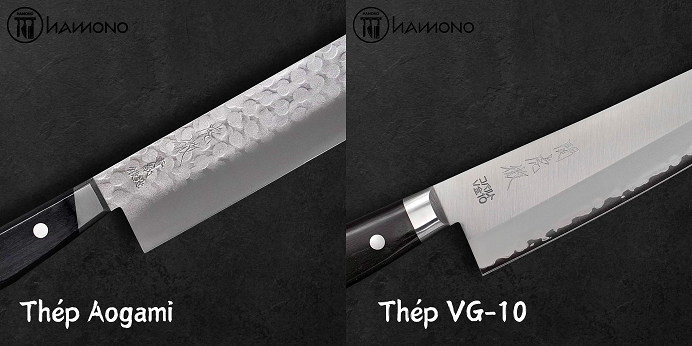VG-10 steel and Aogami steel (Blue Steel) are two highly popular materials used in the production of Japanese kitchen knives.
In Vietnam, most high-end Japanese knives available on the market typically use VG-10 steel, while finding a knife made from Aogami steel is relatively rare.
Each of these steels has its own unique characteristics and advantages. Let’s explore and compare the key aspects of both types with HAMONO.

1. Manufacturer
-
VG-10 Steel: VG-10 is produced by Takefu Special Steel Co., Ltd., a company based in Echizen, Fukui Prefecture, Japan. Takefu Special Steel is well known for its high-quality stainless steels used in kitchen knives and razors.
-
Aogami Steel: Aogami is manufactured by Hitachi Metals, Ltd., one of Japan’s leading steel producers. Hitachi Metals specializes in premium high-carbon steels, including Aogami, which is widely favored for crafting traditional Japanese kitchen knives.
2. Chemical Composition

3. Hardness
-
VG-10 Steel: Typically has a hardness rating of 60–62 HRC on the Rockwell Hardness Scale.
-
Aogami Steel: Usually falls between 62–64 HRC, and can be even harder depending on the specific heat treatment process used by each blacksmith or manufacturer.
4. Edge Retention
-
VG-10 Steel: Offers good edge retention thanks to its well-balanced combination of hardness and wear resistance.

-
Aogami Steel:Provides excellent edge retention due to its high hardness. However, it can be more prone to chipping if misused - such as chopping through bones, twisting, or prying.
5. Ease of Sharpening
-
VG-10 Steel: Relatively easy to sharpen, but requires proper tools and technique to achieve the desired sharpness.
-
Aogami Steel: Generally easier to sharpen than VG-10, and can achieve an extremely fine, razor-sharp edge.
6. Corrosion Resistance
-
VG-10 Steel: Excellent corrosion resistance thanks to its high chromium content, making it suitable for humid and wet environments.
-
Aogami Steel: Poor corrosion resistance. It is prone to rust if not carefully maintained. It should be thoroughly dried and lightly oiled after each use.
7. Price

-
VG-10 Steel: Usually falls within the mid to high price range due to its popularity and well-rounded performance.
-
Aogami Steel:Generally more expensive than VG-10, largely because of its rarity and superior sharpness capabilities.
8. Application & Style
-
VG-10 Steel: Commonly used in modern kitchen knives, ideal for users who want a durable, low-maintenance blade.
-
Aogami Steel: Often found in traditional Japanese knives, suitable for those who appreciate the craftsmanship of Japanese blades and are willing to invest in proper care.
Conclusion
Choosing between VG-10 and Aogami steel depends on your usage needs and maintenance habits.
VG-10 is a great option for those who want a durable, easy-to-maintain knife, while Aogami is an excellent choice for users who value extreme sharpness and are committed to proper knife care.